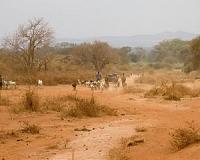 |
Wellington (AFP) March 26, 2010 A week after a UN conference failed to ban trade in the critically endangered Atlantic bluefin tuna, environmentalists are warning of the possible extinction of its southern hemisphere cousin. The UN Convention on International Trade in Endangered Species (CITES) conference that ended Thursday voted heavily against a plan by the United States and European Union to ban trade in Atlantic bluefin tuna, the population of which has fallen by about three-quarters in the last 40 years. But southern bluefin tuna appear in even worse trouble, and environmentalists blame Australia, Japan, New Zealand and other nations for pushing the species closer to extinction and are calling for the fishery to be closed. Most southern bluefin, which reach up to 200 kilograms in weight, are caught in southern Australian waters, around New Zealand and off South Africa. While prices in Tokyo's fish market about a third lower than for northern hemisphere bluefins, each southern bluefin can sell for thousands of dollars. Japan and New Zealand voted against the CITES ban on trade in Atlantic tuna and Australia announced it would not vote in favour. Both Australia and New Zealand argue that fishing restrictions are more effective than a trade ban. But Greenpeace New Zealand oceans campaigner Karli Thomas said their decisions partly reflected a desire to avoid pressure to close the southern bluefin fishery. Numbers of the southern bluefin have shrunk to less than five percent of stocks before commercial fishing began, according to the Commission for the Conservation of Southern Bluefin Tuna (CCSBT), a quota-setting body comprising Australia, Indonesia, Japan, New Zealand, South Korea and Taiwan. The industry is worth about 900 million US dollars a year, with the vast majority of fish ending up in Japan. Annual southern bluefin catches reached 80,000 tonnes in the 1960s and the commission was set up in 1994 as numbers continued to fall following the introduction of voluntary quotas in the 1980s. Conservationists say the fishery has reached such desperate straits that there is no alternative to closure if stocks are to rebuild. "We've looked at the (CCSBT) scientific report that came out last year and from that it's clear that the only option that's going to bring about even a modest recovery of the stock is a zero catch," Thomas told AFP. The commission aims to restore the fishery to 20 percent of pre-fishing levels in the next 20 years but admits that won't happen unless catches are cut drastically. The CCSBT has agreed to reduce fishing of southern bluefin by an average of 20 percent this year and in 2011 from 11,810 tonnes to an average of 9,449 tonnes. But that is not enough to ensure the future for southern bluefin, Greenpeace says. "What they (the commission) prioritise time and time again is not just the interests of the fishing industry but the short-term interests of the fishing industry," said Thomas. Australia accounts for around 4,000 tonnes of the catch, Japan for nearly 2,300 tonnes, with the bulk of the rest divided between South Korea, Taiwan, New Zealand and Indonesia. But as part of the reduced global catch, New Zealand has been allowed to increase its quota, a move that has incensed environmentalists. New Zealand Fisheries Ministry chief executive Wayne McNee confirmed Thursday the catch limit in New Zealand waters would rise from 420 tonnes to 532 tonnes this year. But he said New Zealand had been a leading voice in reducing the global catch, and the rise in its own limit reflected the fact that its share was too low in the past. Brian Jeffriess, chief executive of the Australian Southern Bluefin Tuna Industry Association, argues the gloomy predictions are wrong and that bluefin numbers are starting to rise again. He blamed the poor state of the fishery on Japan, which had admitted overfishing its quotas up to 2006. Since then Japan has accepted a slashing of its quota and increased monitoring. Jeffriess said aerial surveys by Australian scientists and reported catch rates by Japanese vessels had shown rising numbers of fish since 2008. "We are very confident the fishery is on the right track for recovery," he told AFP, adding he believed fishing quotas should start rising again from 2014.
Share This Article With Planet Earth
Related Links Farming Today - Suppliers and Technology
 Climate: Poor nations most at risk from plant loss
Climate: Poor nations most at risk from plant lossParis (AFP) March 24, 2010 Global warming could reduce the range of plant biodiversity by more than nine percent by century's end, and poor countries least to blame for the problem will be worst hit, a study published on Wednesday says. German biologists used the UN climate panel's computer models for possible temperature rise, and crunched through data on "capacity for species richness," or CSR, meaning the likely co ... read more |
|
| The content herein, unless otherwise known to be public domain, are Copyright 1995-2010 - SpaceDaily. AFP and UPI Wire Stories are copyright Agence France-Presse and United Press International. ESA Portal Reports are copyright European Space Agency. All NASA sourced material is public domain. Additional copyrights may apply in whole or part to other bona fide parties. Advertising does not imply endorsement,agreement or approval of any opinions, statements or information provided by SpaceDaily on any Web page published or hosted by SpaceDaily. Privacy Statement |